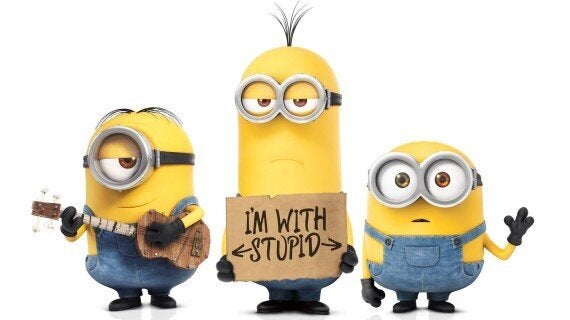
Students are proposing a theory the complex genetic make up of humans could be mirrored in that of those loveable yellow creatures, Minions.
Krisho Manoharan and Ruth Sang Jones, two natural science students at Leicester University, analysed the 'minion genome' in the student journal of their university's Centre for Interdisciplinary Science. Through summarising the biological traits of minions and taking into account their supposed arrival onto land approximately 400m years ago, the students were able to speculate the make up of these cartoon creations' genome.
One of the possible components suggested were homoeotic genes, which are responsible for organism development. Jones and Manoharan event went as far as to study the proportions of minions, their small limbs and enlarged craniums appearing as possible symptoms of hypochondroplasia. This disease is usually caused by a mutation of the FGFR3 gene.

Could we be the descendants of minions?!
The enlarged appearance of a minion's eyes, appearing to work more like a camera-lens than a human eye, can be linked to the Pax6 gene, responsible for eye and brain development. Mutations of this gene have been known to cause a variety of eye disorders.
In humans, spoken articulation can be hindered by problems with the FoxP2 gene which potentially explains how the speech of minions is broken and repetitive but despite its simplification, mirrors human language.
Finally, Xanthophores are responsible for colouration of animals and therefore would be the cause of the bright yellow pigmentation of minions.
If minions were a real species and not an animated character, it is semi-plausible that an evolutionary link may exist. Minions hold similar genetic properties to us, despite the fact that elements of their genome surpass human qualities, such as lack of reproductive tendencies and what appears to be immortality. The findings of the paper ultimately suggest that minions would be the result of a series of genetic mutations.
The University of Leicester hopes that this course will encourage students to use the vast quantities of information available to them and combine it with creativity in order to produce a novel concept. Dr Cheryl Hurkett of the Centre for Interdisciplinary Science points describes how "The Interdisciplinary Research Journal module models this process, and gives students an opportunity to practise this way of thinking."
She added: "I am always pleased to see my students engaging so enthusiastically with the subject. I encourage them to be as creative as possible with their subject choices as long as they can back it up with hard scientific facts, theories and calculations! Krisho Manoharan and Ruth Sang Jones's paper examining the 'minion genome' is a prime example of this aim."
The paper is available to read here.